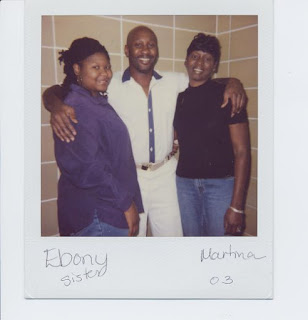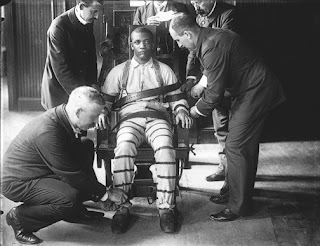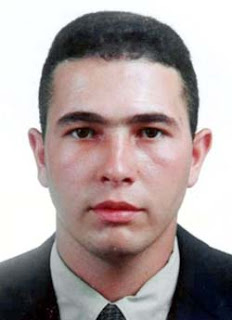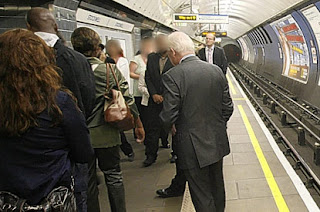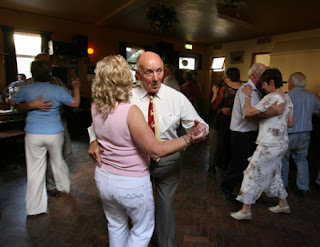 Bombast! The power of a 18 pounder Blomefield cannon at Tower No. 7 Killiney, Co. Dublin
Bombast! The power of a 18 pounder Blomefield cannon at Tower No. 7 Killiney, Co. Dublin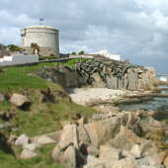 Tower No. 11 - Joyce Tower Sandycove, Co. Dublin.
Tower No. 11 - Joyce Tower Sandycove, Co. Dublin.Growing up in Dublin Martello Towers were like old friends which beaded the coastline around the city like a string of pearls. Dublin City has a wonderful maritime location with a sweeping bay with to the north the rugged promontory of Howth with its cliffs and fishing harbour and to the north the dunes of Portmarnock and the port of Malahide with the Donabate peninsula beyond. To the south of the harbour you have the magnificent South Bull Wall designed by Captain Bligh of Mutiny on the Bounty fame and the sweep of the bay towards Dun Laoghaire, Sandycove and beyond Dalkey the heights of Killiney Hill with beyond a deep water and flat strand before you arrive at Bray Head.
http://daithaic.blogspot.com/2007/08/dublins-fair-city.html To protect the city from invasion by the French 12 towers were built to the North and 16 to the South along with complementary artillery batteries and signal towers. Loughlinstown Camp, inland from the Towers, was disbanded in 1799 after the 1798 Rebellion when the authorities became nervous about having such a large garrison of mainly Irish Troops so close to Dublin. The Towers around Dublin were mainly built in 1801/03 and over the years many of these towers became disused or fallen into other uses so their purpose is not clearly understood. That is why the authentic restoration of Tower No. 7 on Killiney Hill along with its glacis, musket points and artillery battery is an exciting event, all the more laudable due to the restoration being completed by an altruistic private individual.
 Martello Tower Balbriggan, North Co, Dublin.
Martello Tower Balbriggan, North Co, Dublin.Martello towers (or simply Martellos) are small defensive forts built in several countries of the British Empire during the 19th century, from the time of the Napoleonic Wars onwards. They stand up to 40 feet (12m) high (with two floors) and typically had a garrison of one officer and 15-25 men. Their round structure and thick walls of solid masonry made them resistant to cannon fire, while their height made them an ideal platform for a single heavy artillery piece, mounted on the flat roof and able to traverse a 360° arc. A few Martello towers were surrounded by a moat for extra defence. They were used throughout the 19th century, but became obsolete with the introduction of powerful rifled artillery. Many have survived to the present day, often preserved as historic monuments.
 Finnevarra Martello Tower and ruins of Gunners Quarters, Galway Bay
Finnevarra Martello Tower and ruins of Gunners Quarters, Galway BayMartello towers were inspired by a round fortress, part of a larger Genovese defence system, at Mortella Point in Corsica. Since the 15th century, similar towers had been built at strategic points around Corsica to protect coastal villages and shipping from North African pirates. They stood one or two stories high and measured 12-15 m (36-45 ft) in diameter, with a single doorway 5 m off the ground that could only be reached by climbing a removable ladder. The towers were paid for by local villagers and staffed by watchmen (known as torregiani) who would signal the approach of unexpected ships by lighting a fire on the tower's roof. This would alert the local defence forces to the incoming threat. Although the pirate threat subsequently dwindled, the Genovese built a newer generation of circular towers which were used to ward off later foreign invasions.
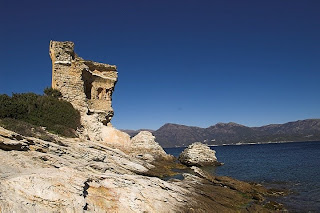 Punta Mortella, Corsica - The original tower blown up by the British Navy
Punta Mortella, Corsica - The original tower blown up by the British NavyOn 7 February 1794, the tower at Mortella Point was attacked by two British warships, HMS Fortitude (74 guns) and HMS Juno (32 guns), and was eventually captured by land-based forces under Sir John Moore after two days of heavy fighting. Vice-Admiral Lord Hood reported:
"...The Fortitude and Juno were ordered against it, without making the least impression by a continued cannonade of two hours and a half; and the former ship being very much damaged by red-hot shot, both hauled off. The walls of the Tower were of a prodigious thickness, and the parapet, where there were two eighteen-pounders, was lined with bass junk, five feet from the walls, and filled up with sand; and although it was cannonaded from the Height for two days, within 150 yards, and appeared in a very shattered state, the enemy still held out; but a few hot shot setting fire to the bass, made them call for quarter. The number of men in the Tower were 33; only two were wounded, and those mortally."
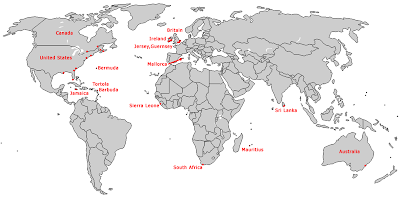 Martello towers worldwide map
Martello towers worldwide mapThe British were impressed by the effectiveness of the tower against their most modern warships and copied the design. However, they got the name wrong, misspelling "Mortella" as "Martello". The ancient tower of Punta Mortella guarded the Gulf of St - Florent since the second half of the 16th century, when it was built (around 1563) according the plan of Italian architect Giacomo Palearo as a part of the Genoese defensive system.The tower had two 18-pounder guns on top and made the bay impossible for the British to use in their invasion of February 1794. The British later blew up the tower but were so impressed that from 1805 they based their own Martello tower coastal defences against Napoleon on it. They corrupted the Italian name "mortella" (myrtle) into "martello".
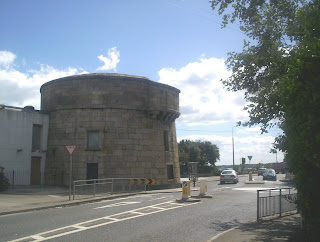 Sandymount Tower today
Sandymount Tower today As a Tram terminus 1925
As a Tram terminus 1925A similar purpose lies behind another of Britain's great, and much misunderstood, Napoleonic defences - the chain of 103 Martello Towers stretching from Seaford in the west to Aldeburgh on the East Anglian coast built between Spring 1805 and 1812.
These squat, ovoid-shaped brick-built towers are immensely strong. The basic principle of the towers is their rounded angled shape helps them to deflect shot rather than taking the impact full on. Essentially their structure, with or without the central pillar in the larger towers, plays to the structural strength of the construction material by having a quasi parabolic shell structure so all forces from inward munitions are mainly resolved by the construction material being in compression where it is at its strongest. Often there is a protective glacis, or grassed ramp, in front of the tower to deflect incoming cannon and provide a clear field of fire for the tower’s muskets. In addition the circular tower with its inward angle going backwards as you go up in height deflects the incoming shot minimising damage to the tower which is normally oval rather than circular with the walls thicker on the sea-side. The sheer mass of the towers also allows them to absorb the force from the incoming fire and deflect the energy off its rounded structure. Also due to their siting incoming cannon fire was normally in an upward trajectory losing much of its velocity and kinetic energy in the process. Conversely the cannon on the cradle of the Martello had a clear 360° line of fire in a downward angle gaining velocity in its trajectory. Taken in conjunction with the sophisticated ventilation and drainage / water storage systems built into the towers it will be appreciated that these were a deceptively cleverly engineered piece of military engineering which gave considerable protection and autonomy to the defending garrison.
In Britain these towers tended to be constructed in dense overburnt engineering brick and in Ireland in dressed granite. Whatever the materials used the construction was substantial and of the highest standard which is why so many are still extant.
Martello Towers were the idea of Captain William Ford of the Royal Engineers and they were sited roughly 600 yards apart and each mounted a long-range 24 pounder cannon. The aim was to cover the most likely landing beaches and to confuse any French landing while British reserves and Royal Navy ships were rushed to the area. These towers were never tested which is a great tribute. The best defence is that which deters attack and certainly the French regarded these little 'bulldogs' as a formidable barrier. With hindsight it appears that all these defences were, essentially, pointless since Nelson's victory at Trafalgar in October 1805 - at the very moment the construction of the Martello Tower system was getting under way - made a French invasion of Britain a virtual impossibility.
 Defensive Features
Defensive FeaturesBut in late 1805 the picture was not quite so clear. After the destruction of his fleet at Trafalgar Napoleon went on to win, in December 1805, the vastly important victory at Austerlitz that confirmed the French as the military and political masters of Europe. A French fleet could be reconstructed and, as far as the British could see, it was just a matter of time before the French were again in a position to invade. It was not until 1812 when Napoleon and his allies were smashed in Russia that the invasion of Britain was clearly beyond the French - and in this year the construction of the chain of Martello towers ceased.
After a short truce (and the much ignored Treaty of Amiens in 1802), war again broke out between England and France in 1803 and in view of past invasion attempts by the French, the British drew up plans to fortify likely landing places in Britain and around the coasts of Ireland. British spies could again report that Boulogne had become an enormous Camp for a French Army of over 130.000 men and 22,000 landing boats poised ready to invade Britain. The Royal Navy also made known their presence to the French and was ready to prevent the invasion force from leaving French waters.
A comprehensive plan of fortifications was approved by the enactment of the National Defence Act 1804 to protect the English coasts from invasion and this plan was also extended to include Ireland. The principal feature of the network of fortifications being constructed on the Coasts of England and Ireland was The Martello Tower. 74 Towers were built between Folkestone in Kent and Seaford, 12 miles west of Eastbourne. These are described as the South Coast towers and numbered (1-74) from east to west. A further 29 towers were built on the East coast between Point Clear in Essex and Aldeburgh in Suffolk. 50 Towers are known to have been built in Ireland. In Ireland the thought of a French Invasion had not been entirely theoretical. There had in fact been one actual and two abortive invasions in support of the United Irishmen and Irish Independence.
http://daithaic.blogspot.com/2008/03/years-of-french.htmlThe interior of a Martello tower was divided into three stories (sometimes with an additional basement). The ground floor served as the magazine and storerooms, where ammunition, stores and provisions were kept. The garrison of 24 men and one officer lived in a casemate on the first floor, which was divided into several rooms and had fireplaces built into the walls for cooking and heating. The officer and men lived in separate rooms of almost equal size. The roof or terreplein was surmounted with one or two cannon on a central pivot which enabled them to be turned through up to 360 degrees. A well or cistern was provided within the fort to supply the garrison with fresh water. An internal drainage system linked to the roof enabled the cistern to be refilled with rainwater.
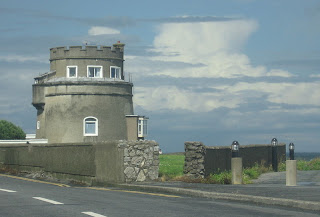 Portmarnock Martello Tower, Co. Dublin
Portmarnock Martello Tower, Co. DublinA number of Martello towers were built around the coast of Ireland, especially along the east, from Millmount (Drogheda), to Bray, around Dublin Bay but also around Cork Harbour on the south coast. On the east coast, concentrated mainly around Dublin Bay, the towers were in line of sight of each other, providing the ability to communicate with one another, or warn of any incoming attacks. Possibly the most famous is the Martello tower in Sandycove, near Dún Laoghaire, in which James Joyce lived for a few days. Joyce shared the tower with Oliver St. John Gogarty, then a medical student but later to become famous in Irish history as a surgeon, politician and writer. The fictional character Stephen Dedalus lives in the tower with a medical student, Malachi "Buck" Mulligan, in Ulysses. The character Buck Mulligan was based by Joyce on Gogarty. Known as the James Joyce Tower, it is now a museum dedicated to Joyce.
http://daithaic.blogspot.com/2008/06/james-joyce-and-me.htmlA number of other Martello towers are extant nearby at Bulloch Harbour, Dalkey Island, Williamstown, Seapoint and Sandymount and Martello towers feature in many literary works set in Dublin. On the north side of the city, Martello towers can be found in Portmarnock, Howth, and Sutton and on both Ireland's Eye and Lambay Island. During the 1980s Bono owned the Martello tower in Bray, County Wicklow.
 Dublin Bay with Killiney in the bottom right
Dublin Bay with Killiney in the bottom right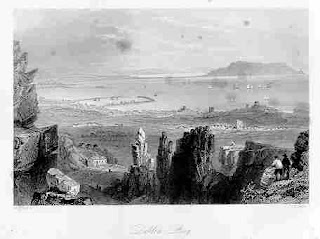 Dublin Bay c. 1820
Dublin Bay c. 1820During the 19th century Fenian uprising, Monning Martello tower near Fota Island in Cork Harbour was briefly captured and held by the famous Captain Mackey and is believed to have been the only one ever captured. The tower at Seapoint, County Dublin, is the headquarters of the Genealogical Society of Ireland, while the restored tower at Ilnacullin is a feature of an island garden in Glengarriff, County Cork. Several other towers are still extant, including one at Rathmullan (the flight of the Earls), County Donegal.
There are generally three sizes constructed in Ireland and Tower No. 7 in Killiney is the smallest size without the central pillar typical of the larger structures. In England the towers were generally the larger type with a massive brick pillar which rose from the foundations to the roof to support the weight of the gun, and provided the base for the central pivot, around which the gun carriage could turn through 360 degrees. The original 24-pounder cannon had a range of about 1000 yards.
Once the bricks had been delivered to the proposed tower sites, work began. It took roughly 500,000 bricks to construct each tower; such was the thickness of the walls, which decreased from base to top. The towers therefore sloped from a wider base to a narrower top, and were not truly round, but slightly elliptical, the thicker part of the walls facing towards the sea. This was designed to help enemy cannon balls to bounce off the walls harmlessly. As different builders were employed along the coast, tower dimensions can vary.
Structural Features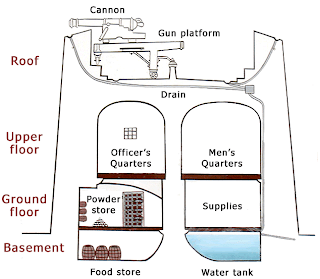
The towers were an incredible feat of engineering - the sheer complexity of the structure can only be marvelled at. Foundations were sunk to an unknown depth, and consisted of large stones laid roughly in the outline of a circle. The tower was then built up from this solid rock base. The bricks were bonded in “hot lime mortar”, which was a mixture of lime, ash and hot tallow. The resulting bond was phenomenally hard. Experiments had been conducted at Woolwich by the Royal Engineers prior to construction, to determine the best mix. Cannonballs were fired at the experimental walls, and were found to bounce off. This was partly due to the roundness of the shot not being able to get sufficient contact with the surface of the rounded and sloping tower walls. It was not until the birth of the Rifled Muzzle-Loader (RML) gun in the 1860's, with its pointed shells, that the Martello's walls were really under threat, and even then they gave a good account of themselves. The external surface of the tower was coated with a tough cement covering known as “stucco”, to seal in the brickwork.
The core of the larger Martello structures was the central pillar. It was designed to support the first floor, the magnificent vaulted ceiling and roof, as well as the gun. Up to first floor level it was about 1.5m thick, then being cut back to 1.4m to hold the floor. It then rose up and arched out to support the vaulted ceiling, said to be as much as 3m thick. Inside the pillar was encased an old cannon, no longer in use. This was used to hold the centre-pin around which the gun carriage rotated.
The top of the pillar was capped with a granite slab when it reached the gun platform. It was vital that the towers did not become damp inside, as this would cause the floor and room partitions to decay, not to mention the effect that damp gunpowder had in preventing cannon firing. Air vents were therefore ingeniously built into the brickwork from the parapet and windows to carry air into the magazine area, stairway and first floor.
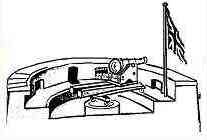 Rooftop Cannon
Rooftop Cannon
Vents were placed just above the fire step on the roof and were taken down to just below the wooden floor level, in an attempt to keep damp to a minimum. Another vent was run from the roof and down into the arch of the staircase passage, which also had a vent that led into the garrison's quarters in the form of a circular hole just to the left of the doorway to the stairs.
Two circular vents were let into the top of the window arches and these led around the walls and down to the ventilation alcoves in the magazine. If the powder, fuses and musket cartridges became damp they would be useless, and would effectively render the tower defenceless. Also incorporated into the walls was the means by which rainwater from the roof was piped down into the cistern. Drains were sunk into the roof, and culminated into a system of lead pipes that were carried down to the foundations in a recess that ran the length of the tower.
The ground floor of the tower was devoted to storage of materials and supplies. The magazine was built into the thickness of the sea wall, which is surprising, as it must have weakened the wall which was designed to be the strongest. In the lockers were stored the dangerous materials, such as the gunpowder and slow match. The magazine was walled off from the rest of the floor for safety reasons. Some towers had storage areas divided up by wooden partitions. The ground floor was not lit, apart from a lantern on a special shelf, which lit the magazine area from behind a glass window, to prevent naked flame from being introduced into the gunpowder supply. The magazine was shut off by a door which was lined with copper sheet. This was because copper is less likely to cause a spark, which could be very dangerous, given the close proximity to a supply of gunpowder.
The garrison's living quarters were situated twenty feet above ground level on a wooden floor. Stone corbels built into the walls supported the outer edges of the floor, whilst the central column was cut back to support the inner side. Despite the air vents built into the walls at ground and first floor level, the towers did not dry out enough. The method of scraping the floorboards and treating them with quick lime failed to stop dry rot setting in, as nearly all original floors have now gone. Another fire precaution was the use of wooden dowels to fix the boards down instead of nails. This was to ensure that the hobnails in the soldiers' boots did not cause sparks to fly.
The roof was the platform for the single cannon, originally a 24-pounder, and later a 32-pounder. A rotating oak carriage allowed the gun to be rotated through 360 degrees, with the use of block and tackle hooked onto iron rings built into the parapet wall. The roof consisted of raised granite firestep around which ran an iron track (known as a 'racer') for the gun carriage, another racer being on the central pivot. The parapet coping was of a durable sandstone, and was cut in a fashion so that it sloped downwards to enable the garrison to shoot closer to the tower base with musket fire should enemy infantry attempt to storm the walls. The chimneys from the fireplaces were built into the walls and culminated in a pair of chimney stacks on the parapet. The placement of the chimneys may have been deliberate, to prevent the cannon from easily 'muzzle-sweeping' a neighbouring tower or battery, although if the need arose, the stacks would probably have been unceremoniously removed to clear the gun's field of fire.
Tower No. 7, Killiney, Dublin.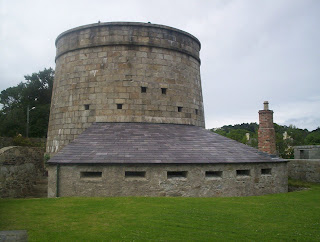
For only the second time in over 200 years, No.7 Martello Tower, in Killiney, Co. Dublin, Ireland, was inaugurated on Saturday, 12th July 2008. This was (almost) the culmination of a project aimed at restoring the Tower to its original state. Niall O'Donoghue has undertaken the restoration at great expense, both financially and in terms of effort, and the result is stunning.
The smaller Killiney Martello Tower (Tower No. 7) is a free-standing, compact, squat, circular, two-storey structure built over a vaulted cellar with a parapet- protected roof which has a fixture for a large traversing cannon. The tower stands 10m high, with bomb-proof walls, over 3 metres thick in places. It is built with large granite blocks and is a magnificent feat of engineering.
 Major La Chaussée's original analysis of the vulnerability of the Bay to a French attack.
Major La Chaussée's original analysis of the vulnerability of the Bay to a French attack. 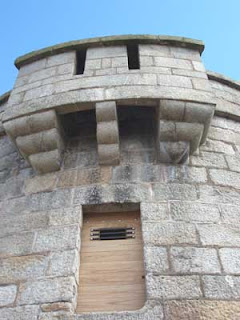 Door Tower No. 7
Door Tower No. 7There is a stone staircase to the roof. The first- floor was the garrison's living quarters for eleven men and one officer. There were 2 rooms on this floor with one window & one fireplace in each. The entrance door was on this floor also. It was 3 m from the ground and access was by a ladder, which could be be withdrawn into the tower in an emergency
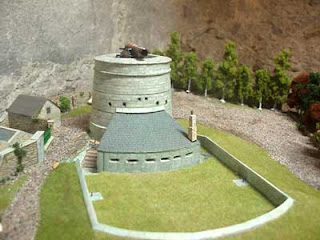 Model of Tower No. 7
Model of Tower No. 7The latrines were outside in the corner of the grounds. The ground floor was devoted to storage of materials and supplies. Incorporated in it was ammunition’s magazine which was walled off for safety reasons. The Tower is surrounded by a stone wall with a 3m wide and sloping embankment in front so that any attackers could not hide behind it. In front of the tower on the seaward side there was a musket firing point overlooking the glacis and in its original form there would have been an artillery battery of three guns facing seaward.
 The Captain's Quarter's
The Captain's Quarter's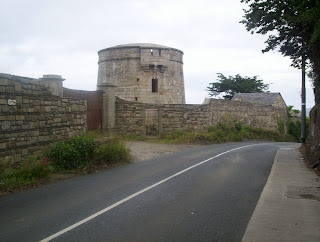 Tower 7 from Killiney Hill Road before restoration
Tower 7 from Killiney Hill Road before restorationNo. 7 Tower was part of the defences of Killiney Bay against a possible French invasion in the period 1804 to 1815. The other towers and batteries have suffered a variety of fates, but this one was rescued and restored to its original state by Niall O'Donoghue, who bought the much neglected site off the local council where it had been used as a maintenance yard storing building materials and equipment.
 The "new" cannon in its rotating cradle
The "new" cannon in its rotating cradle The Gunner O'Donoghue
The Gunner O'DonoghueThe project has been long and meticulous and the (almost) finished Tower was inaugurated with much ceremony, jollity and efficiency on the 12th of July 2008. The newly cast 18 pdr. Blomefield cannon was successfully fired and a blaze of colour was added by the Redcoat finery and arms of the firing party and their escort. Musket volleys were also fired as a teaser to the main event.
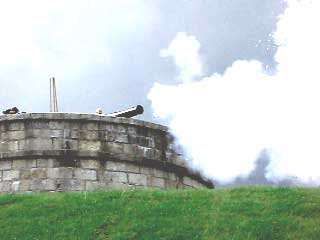 The 18 Pounder's Bloomfield canon's Bombast
The 18 Pounder's Bloomfield canon's Bombast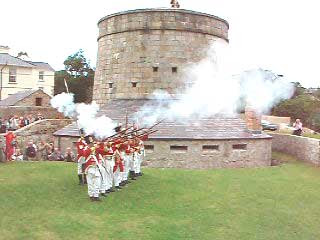 A volley of muskets
A volley of musketsAs well as the tower Niall has restored the musket firing point and glacis and rebuilt the gunner’s cottage on the site in reclaimed materials. However the piece de resistance is the “new” 18 pounder Blomefield cannon he had cast in the UK and the authentic oak cradle and tackle he had constructed. His obsession knew no bounds as he then completed a gunnery course at Fort Nelson, Hampshire so he could be licensed for the ceremonial “bombast” which echoed around Dublin Bay on the 12th July last. He is now in the privileged position of having a cannon poised over his neighbours which given the territoriality of some of the local inhabitants is no bad thing!
 Inspecting the Redcoats - not a common sight in modern Ireland
Inspecting the Redcoats - not a common sight in modern Ireland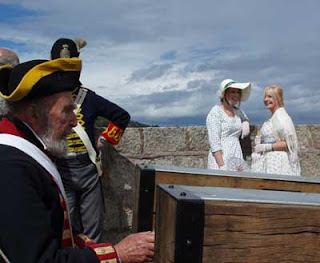 The Ladies were in attendance
The Ladies were in attendanceOne final item to report, despite the redcoat eyes and telescopes being on high alert and scanning the horizon the French did not show on the day. Plus ca change, plus c'est la meme chose, n'est-ce pas?
http://daithaic.blogspot.com/2008/03/years-of-french.htmlI’m very grateful to Pól Ó Duibhir for allowing me to use material and photos from his site on the inauguration of Tower No. 7. But mainly I am grateful for discovering a wonderful site which has much of Irish, Military and Local interest to commend it plus a Blog as Gaeilge. Have a look;
http://www.photopol.comThis is Pól’s article on Loughlinstown Camp which was inland protecting Killiney Bay before the Towers were built. It was disbanded in 1799 after the 1798 Rebellion when the authorities became nervous about having such a large garrison of mainly Irish Troops so close to Dublin.
http://www.photopol.com/french/camp.htmlAnd here is his clever map on Google showing the Defences of Dublin Bay:
http://www.photopol.com/dca/








